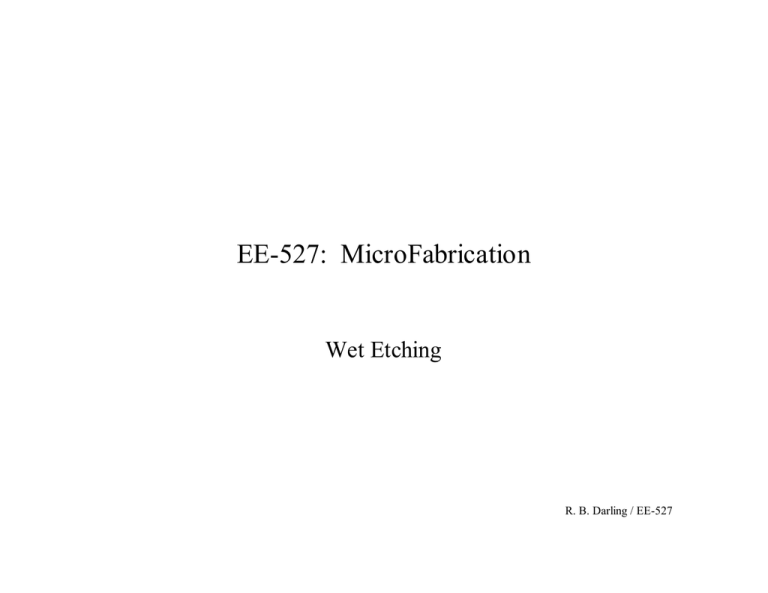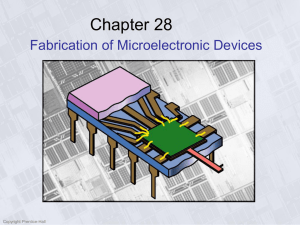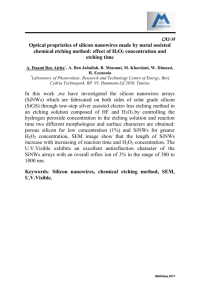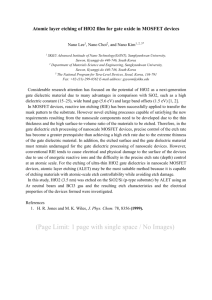EE-527: MicroFabrication Wet Etching R. B. Darling / EE-527
advertisement

EE-527: MicroFabrication
Wet Etching
R. B. Darling / EE-527
Outline
•
•
•
•
•
•
•
Isotropic Si etching
Anisotropic Si etching
Anisotropic GaAs etching
Isotropic etching of SiO2, Al, and Cr
General features of wet chemical etching
Selective etching and etch stops
Interesting etch techniques
– Junction diode etch stops
– Field assisted etching
– CMOS post processing
R. B. Darling / EE-527
Etch Anisotropy
• Isotropic etching
– Same etch rate in all directions
– Lateral etch rate is about the same as vertical etch rate
– Etch rate does not depend upon the orientation of the mask edge
• Anisotropic etching
– Etch rate depends upon orientation to crystalline planes
– Lateral etch rate can be much larger or smaller than vertical etch
rate, depending upon orientation of mask edge to crystalline axes
– Orientation of mask edge and the details of the mask pattern
determine the final etched shape
• Can be very useful for making complex shapes
• Can be very surprising if not carefully thought out
• Only certain “standard” shapes are routinely used
R. B. Darling / EE-527
Etching Chemistry
• The etching process involves:
– Transport of reactants to the surface
– Surface reaction
– Transport of products from the surface
• Key ingredients in any wet etchant:
– Oxidizer
• examples: H2O2, HNO3
– Acid or base to dissolve oxidized surface
• examples: H2SO4, NH4OH
– Dillutent media to transport reactants and products through
• examples: H2O, CH3COOH
R. B. Darling / EE-527
Redox Reactions
• Etching is inherently an electrochemical process:
– It involves electron transfer processes as part of the surface
reactions.
• The oxidation number is the net positive charge on a
species.
• Oxidation is the process of electron loss, or increase in the
oxidation number.
• Reduction is the process of electron gain, or decrease in the
oxidation number.
• Redox reactions are those composed of oxidation of one or
more species and simultaneous reduction of others.
R. B. Darling / EE-527
HNA Etching of Silicon - 1
• Hydrofluoric acid + Nitric acid + Acetic acid
• Produces nearly isotropic etching of Si
• Overall reaction is:
– Si + HNO3 + 6HF → H2SiF6 + HNO2 + H2O + H2
– Etching occurs via a redox reaction followed by dissolution of the
oxide by an acid (HF) that acts as a complexing agent.
– Points on the Si surface randomly become oxidation or reduction
sites. These act like localized electrochemical cells, sustaining
corrosion currents of ~100 A/cm2 (relatively large).
– Each point on the surface becomes both an anode and cathode site
over time. If the time spent on each is the same, the etching will
be uniform; otherwise selective etching will occur.
R. B. Darling / EE-527
HNA Etching of Silicon - 2
• Silicon is promoted to a higher oxidation state at an anodic
site which supplies positive charge in the form of holes:
– Si0 + 2h+ → Si2+
• NO2 from the nitric acid is simultaneously reduced at a
cathode site which produces free holes:
– 2NO2 → 2NO2− + 2h+
• The Si2+ combines with OH− to form SiO2:
– Si2+ + 2OH− → Si(OH)2 → SiO2 + H2O
• The SiO2 is then dissolved by HF to form a water soluble
complex of H2SiF 6:
– SiO2 + 6HF → H2SiF6 + 2H2O
R. B. Darling / EE-527
HNA Etching of Silicon - 3
• Nitric acid has a complex behavior:
– Normal dissociation in water (deprotonation):
• HNO3 ↔ NO3− + H+
– Autocatalytic cycle for production of holes and HNO2:
• HNO2 + HNO3 → N2O4 + H2O
• N2O4 ↔ 2NO2 ↔ 2NO2− + 2h+
• 2NO2− + 2H+ ↔ 2HNO2
– NO2 is effectively the oxidizer of Si
• Its reduction supplies holes for the oxidation of the Si.
– HNO2 is regenerated by the reaction (autocatalytic)
– Oxidizing power of the etch is set by the amount of undissociated
HNO3.
R. B. Darling / EE-527
HNA Etching of Silicon - 4
• Role of acetic acid (CH3COOH):
– Acetic acid is frequently substituted for water as the dilutent.
– Acetic acid has a lower dielectric constant than water
• 6.15 for CH3COOH versus 81 for H2O
• This produces less dissociation of the HNO3 and yields a higher
oxidation power for the etch.
– Acetic acid is less polar than water and can help in achieving
proper wetting of slightly hydrophobic Si wafers.
R. B. Darling / EE-527
HNA Etching of Silicon - 5
Silicon Anodic Site
Etchant Solution
Si2+ + 2OH− → Si(OH)2 → SiO2 + H2O
Si0 + 2h+ → Si2+
SiO2 + 6HF → H2SiF6 + 2H2O
HNO2 + HNO3 → N2O4 + H2O
N2O4 ↔ 2NO2
2NO2 → 2NO2− + 2h+
2NO2− + 2H+ ↔ 2HNO2
HNO3 ↔ NO3− + H+
Silicon Cathodic Site
R. B. Darling / EE-527
HNA Etching of Silicon - 6
0
100
HF (49%)
25
75
1
50
50
3
500 µm/min
25
100 µm/min
50 µm/min
10 µm/min
2
75
HNO3 (70%)
100
0
100
75
50
25
0
H2 O
R. B. Darling / EE-527
HNA Etching of Silicon - 7
• Region 1
•
– For high HF concentrations, contours are parallel to the lines of
constant HNO3; therefore the etch rate is controlled by HNO3 in
this region.
– Leaves little residual oxide; limited by oxidation process.
Region 2
– For high HNO3 concentrations, contours are parallel to the lines of
constant HF; therefore the etch rate is controlled by HF in this
region.
– Leaves a residual 30-50 Angstroms of SiO2; self-passivating;
limited by oxide dissolution; area for polishing.
• Region 3
– Initially not very sensitive to the amount of H2O, then etch rate
falls of sharply for 1:1 HF:HNO3 ratios.
R. B. Darling / EE-527
Isoetch Contours
EXAMPLE:
HF:HNO3:H2O
3:2:5 ratio by volume
0
100
HF (49%)
20
25
75
50
50
25
500 µm/min
30
100 µm/min
50 µm/min
10 µm/min
75
HNO3 (70%)
100
0
100
75
50
25
0
H2 O
R. B. Darling / EE-527
Anisotropic Etching of Silicon - 1
• Differing hybridized (sp3) orbital orientation on different
crystal planes causes drastic differences in etch rate.
• Typically, etch rates are: (100) > (110) > (111).
• The (111) family of crystallographic planes are normally
the “stop” planes for anisotropic etching.
• There are 8 (111) planes along the ± x ± y ± z unit vectors.
• Intersections of these planes with planar bottoms produce
the standard anisotropic etching structures for (100) Si
wafers:
– V-grooves
– pyramidal pits
– pyramidal cavities
R. B. Darling / EE-527
Anisotropic Etching of Silicon - 2
(100) surface orientation
(111)
54.74
Silicon
(110) surface orientation
(111)
Silicon
R. B. Darling / EE-527
Anisotropic Etching of Silicon - 3
[110]
[100]
SiO 2 mask
[111]
R. B. Darling / EE-527
Hydroxide Etching of Silicon
• Several hydroxides are useful:
– KOH, NaOH, CeOH, RbOH, NH4OH, TMAH: (CH3)4NOH
• Oxidation of silicon by hydroxyls to form a silicate:
– Si + 2OH− + 4h+ → Si(OH)2++
• Reduction of water:
– 4H2O → 4OH− + 2H2 + 4h+
• Silicate further reacts with hydroxyls to form a watersoluble complex:
– Si(OH)2++ + 4OH− → SiO2(OH)22− + 2H2O
• Overall redox reaction is:
– Si + 2OH− + 4H2O → Si(OH)2++ + 2H2 + 4OH−
R. B. Darling / EE-527
KOH Etching of Silicon - 1
• Typical and most used of the hydroxide etches.
• A typical recipe is:
–
–
–
–
250 g KOH
200 g normal propanol
800 g H2O
Use at 80°C with agitation
• Etch rates:
– ~1 µm/min for (100) Si planes; stops at p++ layers
– ~14 Angstroms/hr for Si3N4
– ~20 Angstroms/min for SiO2
• Anisotropy: (111):(110):(100) ~ 1:600:400
R. B. Darling / EE-527
KOH Etching of Silicon - 2
• Simple hardware:
– Hot plate & stirrer.
– Keep covered or use reflux condenser to keep propanol from
evaporating.
• Presence of alkali metal (potassium, K) makes this
completely incompatible with MOS or CMOS processing!
• Comparatively safe and non-toxic.
R. B. Darling / EE-527
EDP Etching of Silicon - 1
• Ethylene Diamine Pyrocatechol
• Also known as Ethylene diamine - Pyrocatechol - Water
(EPW)
• EDP etching is readily masked by SiO2, Si 3N4, Au, Cr, Ag,
Cu, and Ta. But EDP can etch Al!
• Anisotropy: (111):(100) ~ 1:35
• EDP is very corrosive, very carcinogenic, and never
allowed near mainstream electronic microfabrication.
• Typical etch rates for (100) silicon:
70°C
14 µm/hr
80°C
20 µm/hr
90°C
30 µm/hr = 0.5 µm/min
97°C
36 µm/hr
R. B. Darling / EE-527
EDP Etching of Silicon - 2
OH
• Typical formulation:
–
–
–
–
1 L ethylene diamine, NH2-CH2-CH2-NH2
160 g pyrocatechol, C6H4(OH)2
6 g pyrazine, C4H4N2
133 mL H2O
N
catechol
pyrazine
• Ionization of ethylene diamine:
– NH2(CH2)2NH2 + H2O → NH2(CH2)2NH3 +
+
N
OH
OH−
• Oxidation of Si and reduction of water:
H2
C
H2N
C
H2
NH2
ethylene diamine
– Si + 2OH− + 4H2O → Si(OH)6 2− + 2H2
• Chelation of hydrous silica:
– Si(OH)6 2− + 3C6H4(OH)2 → Si(C6H4O2)32− + 6H2O
R. B. Darling / EE-527
EDP Etching of Silicon - 3
• Requires reflux condenser to keep volatile ingredients from
evaporating.
• Completely incompatible with MOS or CMOS processing!
– It must be used in a fume collecting bench by itself.
– It will rust any metal in the nearby vicinity.
– It leaves brown stains on surfaces that are difficult to remove.
• EDP has a faster etch rate on convex corners than other
anisotropic etches:
– It is generally preferred for undercutting cantilevers.
– It tends to leave a smoother finish than other etches, since faster
etching of convex corners produces a polishing action.
R. B. Darling / EE-527
EDP Etching of Silicon - 4
• EDP etching can result in deposits of polymerized Si(OH)4
on the etched surfaces and deposits of Al(OH)3 on Al pads.
• Moser’s post EDP protocol to eliminate this:
–
–
–
–
20 sec. DI water rinse
120 sec. dip in 5% ascorbic acid (vitamin C) and H2O
120 sec. rinse in DI water
60 sec. dip in hexane, C6H14
R. B. Darling / EE-527
Amine Gallate Etching of Silicon
• Much safer than EDP
• Typical recipe:
–
–
–
–
–
100 g gallic acid
305 mL ethanolamine
140 mL H2O
1.3 g pyrazine
0.26 mL FC-129 surfactant
• Anisotropy: (111):(100): 1:50 to 1:100
• Etch rate: ~1.7 µm/min at 118°C
R. B. Darling / EE-527
TMAH Etching of Silicon - 1
• Tetra Methyl Ammonium Hydroxide
• MOS/CMOS compatible:
– No alkali metals {Li, Na, K, … }.
– Used in positive photoresist developers which do not use choline.
– Does not significantly etch SiO2 or Al! (Bond wire safe!)
• Anisotropy: (111):(100) ~ 1:10 to 1:35
• Typical recipe:
–
–
–
–
–
250 mL TMAH (25% from Aldrich)
375 mL H2O
22 g Si dust dissolved into solution
Use at 90°C
Gives about 1 µm/min etch rate
H3C
H3C
CH3
N
OH
CH3
tetramethyl ammonium hydroxide
(TMAH)
R. B. Darling / EE-527
TMAH Etching of Silicon - 2
• Hydroxide etches are generally safe and predictable, but
they usually involve an alkali metal which makes them
incompatible with MOS or CMOS processing.
• Ammonium hydroxide (NH4OH) is one hydroxide which
is free of alkali metal, but it is really ammonia which is
dissolved into water. Heating to 90°C for etching will
rapidly evaporate the ammonia from solution.
• Ballasting the ammonium hydroxide with a less volatile
organic solves the problem:
– Tetramethyl ammonium hydroxide: (CH3)4NOH
– Tetraethyl ammonium hydroxide: (C2H5)4NOH
R. B. Darling / EE-527
Hydrazine and Water Etching of Silicon
• Produces anisotropic etching of silicon, also.
• Typical recipe:
– 100 mL N2H4
– 100 mL H2O
– ~2 µm/min at 100°C
• Hydrazine is very dangerous!
–
–
–
–
–
–
A very powerful reducing agent (used for rocket fuel)
Flammable liquid
TLV = 1 ppm by skin contact
Hypergolic: N2H4 + 2H2O2 → N2 + 4H2O (explosively)
Pyrophoric: N2H4 + O2 → N2 + 2H2O (explosively)
Flash point = 52°C = 126°F in air.
R. B. Darling / EE-527
Anisotropic Etch Stop Layers - 1
• Controlling the absolute depth of an etch is often difficult,
particularly if the etch is going most of the way through a
wafer.
• Etch stop layers can be used to drastically slow the etch
rate, providing a stopping point of high absolute accuracy.
• Boron doping is most commonly used for silicon etching.
• Requirements for specific etches:
–
–
–
–
–
HNA etch actually speeds up for heavier doping
KOH etch rate reduces by 20× for boron doping > 1020 cm-3
NaOH etch rate reduces by 10× for boron doping > 3 × 1020 cm-3
EDP etch rate reduces by 50× for boron doping > 7 × 1019 cm -3
TMAH etch rate reduces by 10× for boron doping > 1020 cm -3
R. B. Darling / EE-527
Anisotropic Etch Stop Layers - 2
heavily boron doped etch stop layer
2-5 µm thick membrane
400 - 500 µm
thick wafer
R. B. Darling / EE-527
Electrochemical Etch Effects - 1
I
V
Si + 4h+ + 2OH→ Si(OH)22+
Si wafer
Pt reference electrode
HF / H2O solution
R. B. Darling / EE-527
Electrochemical Etch Effects - 2
• HF normally etches SiO2 and terminates on Si.
• By biasing the Si positively, holes can be injected by an
external circuit which will oxidize the Si and form
hydroxides which the HF can then dissolve.
• This produces an excellent polishing etch that can be very
well masked by LPCVD films of Si3N4.
• If the etching is performed in very concentrated HF (48%
HF, 98% EtOH), then the Si does not fully oxidize when
etched, and porous silicon is formed, which appears
brownish.
R. B. Darling / EE-527
Electrochemical Etch Effects - 3
I, mA/cm2
n-type Si
OCP:
open-circuit
potential
-2.0
(100) Si in 40% KOH at 60°C
p-type Si
-1.5
-1.0
PP:
passivation
potential
-0.5
0.0
+0.5
+1.0
V, Volts
potential of Pt
reference electrode
R. B. Darling / EE-527
Electrochemical Etch Effects - 4
• Increasing the wafer bias above the OCP will increase the
etch rate by supplying holes which will oxidize the Si.
• Increasing the wafer bias further will reach the passivation
potential (PP) where SiO2 forms.
– This passivates the surface and terminates the etch.
– The HF / H2O solution does not exhibit a PP, since the SiO2 is
dissolved by the HF.
R. B. Darling / EE-527








